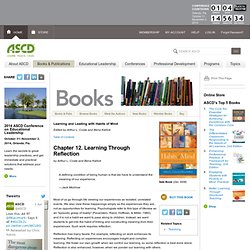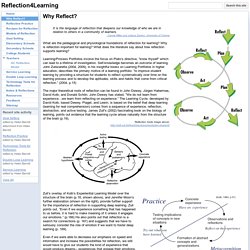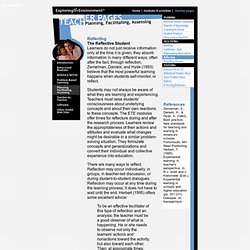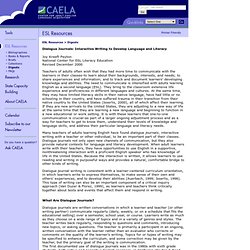

Nwtoolkit.pdf. Learning Through Reflection. Edited by Arthur L.

Costa and Bena Kallick by Arthur L. Costa and Bena Kallick Reflection has many facets. For example, reflecting on work enhances its meaning. Reflection involves linking a current experience to previous learnings (a process called scaffolding). Valuing Reflection The art of teaching is the art of assisting discovery. —Mark Van Doren Teachers who promote reflective classrooms ensure that students are fully engaged in the process of making meaning. In the role of facilitator, the teacher acts as an intermediary between the learner and the learning, guiding each student to approach the learning activity in a strategic way. Unfortunately, educators don't often ask students to reflect on their learning. Learning through Reflection. We learn by experiences that allow us to (Wertenbroch & Nabeth, 2000): Absorb (read, hear, feel) Do (activity) Interact (socialize) In addition, we also learn by reflecting on such experiences (Dewey 1933).

Reflection is thinking for an extended period by linking recent experiences to earlier ones in order to promote a more complex and interrelated mental schema. The thinking involves looking for commonalities, differences, and interrelations beyond their superficial elements. The goal is to develop higher order thinking skills. Many educators consider Dewey (1933) the modern day originator of the concept of reflection, although he drew on the ideas of earlier educators, such as Aristotle, Plato, and Confucius . 9_Learning and Assessing Through Reflection.pdf. Reflection. Why Reflect? - Reflection4Learning. It is the language of reflection that deepens our knowledge of who we are in relation to others in a community of learners.

What are the pedagogical and physiological foundations of reflection for learning? Why is reflection important for learning? What does the literature say about how reflection supports learning? Learning/Process Portfolios involve the focus on Plato’s directive, “know thyself” which can lead to a lifetime of investigation. Self-knowledge becomes an outcome of learning. The major theoretical roots of reflection can be found in John Dewey, Jürgen Habermas, David Kolb, and Donald Schön. Zull’s overlay of Kolb’s Experiential Learning Model over the structure of the brain (p.18, shown above), and Jennifer Moon’s further elaboration (shown on the right), provide further support for the importance of reflection in supporting deep learning.
University of Manchester. ‘It is not sufficient simply to have an experience in order to learn.

Without reflecting upon this experience it may quickly be forgotten, or its learning potential lost. It is from the feelings and thoughts emerging from this reflection that generalisations or concepts can be generated. And it is generalisations that allow new situations to be tackled effectively.’ Teaching Tip: Ending a Day's Class. All too often, meetings end with teachers shouting out a few last-minute reminders as students pack up their books and exit the room.

Instead of a chaotic end to the class, here are a few ideas for wrapping up each meeting in a positive, reflective way. The key to all these learning activities is timing—you must make sure you manage your time well so you can implement these activities while not making them feel rushed. End with a minute paper Minute papers are one of the most common classroom assessment techniques (CATs) advocated by Angelo and Cross.
At the end of each class meeting, have students write for a few moments on a topic such as "What was the most important thing you learned in class today? " or "What questions from today's class remained unanswered? " Think-Pair-Share This common small group activity can be used to encourage reflection and small-scale collaboration at the end of the class period. Sources Angelo, Thomas A. and K. How do I promote student reflection and critical thinking. ETE Teacher Pages. Reflecting The Reflective Student Learners do not just receive information only at the time it is given; they absorb information in many different ways, often after the fact, through reflection.

Zemelman, Daniels, and Hyde (1993) believe that the most powerful learning happens when students self-monitor, or reflect. Students may not always be aware of what they are learning and experiencing. Teachers must raise students' consciousness about underlying concepts and about their own reactions to these concepts. The ETE modules offer times for reflecture during and after the research process. Learners review the appropriateness of their actions and attitudes and evaluate what changes might be desirable in a similar problem-solving situation. There are many ways to reflect. CAELA: ESL Resources: Digests.
Joy Kreeft Peyton National Center for ESL Literacy Education Revised December 2000 Teachers of adults often wish that they had more time to communicate with the learners in their classes-to learn about their backgrounds, interests, and needs; to share experiences and information; and to track and document learners' developing knowledge and abilities.

The need to communicate is intensified with adults learning English as a second language (ESL). They bring to the classroom extensive life experience and proficiencies in different languages and cultures. At the same time, they may have limited literacy skills in their native language, have had little or no schooling in their country, and have suffered trauma in their transition from their native country to the United States (Isserlis, 2000), all of which affect their learning. 58057_rev_57794_ch4.pdf.